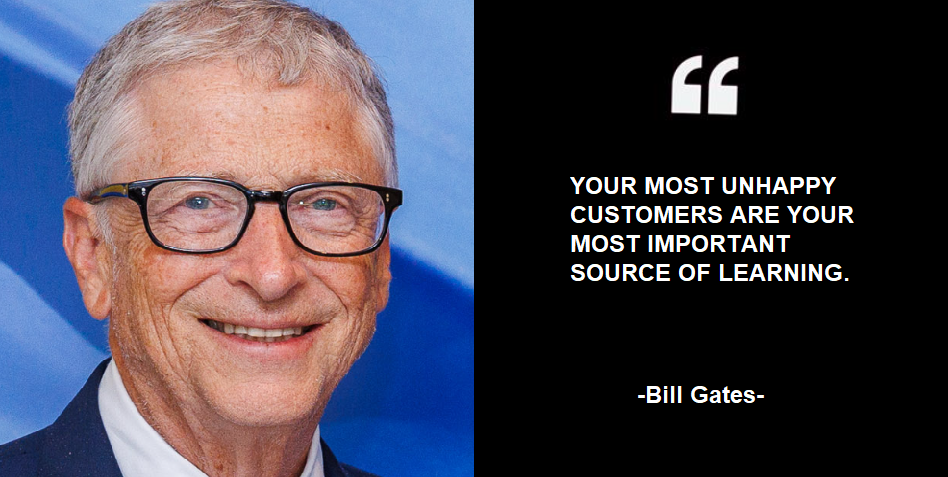Table of Contents
Introduction
In 2025, the lines separating social interaction from online shopping have almost disappeared. Social media has transitioned from merely a connection platform to a vibrant marketplace where engagement fuels conversion.
The move towards social commerce is changing the way consumers find, assess, and buy products. Platforms such as Instagram, TikTok, and YouTube are evolving into comprehensive shopping ecosystems that merge content with commerce.
As technology progresses and consumer expectations grow, social media is becoming the core of contemporary e-commerce. This transformation is not solely about convenience; it is also reshaping the shopping experience through personalization, community, and immediate satisfaction.
The Rise of Social Commerce
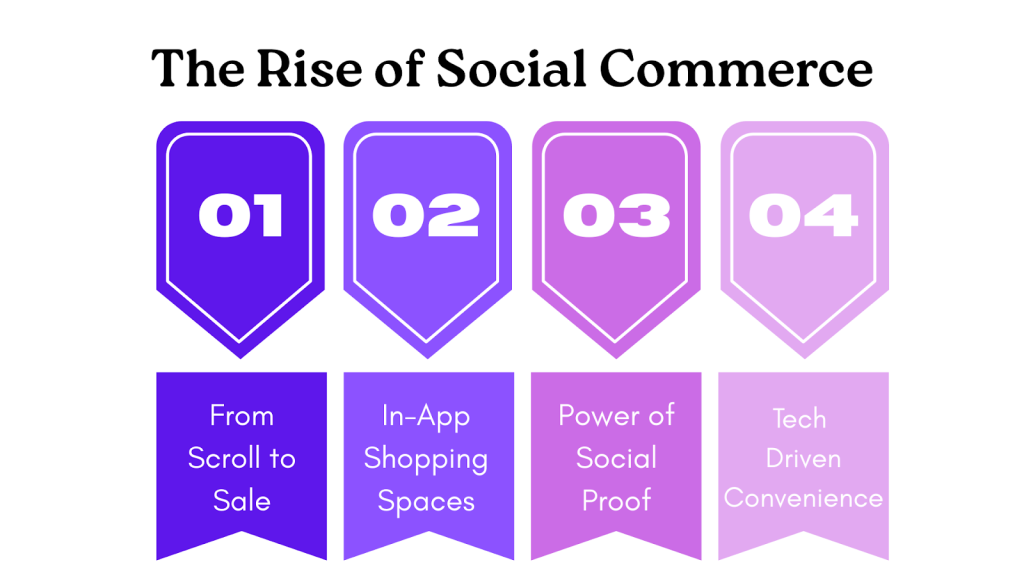
Social commerce represents a significant milestone in the development of online retail.
- From Scroll to Sale: Social platforms have turned product discovery into direct purchasing. Users can now explore, evaluate, and buy—all without leaving their favorite apps.
- In-App Shopping Spaces: Consumers prefer to shop in the same spaces they socialize. Instagram, TikTok, and Pinterest now function as personalized storefronts, blending content with commerce.
- Power of Social Proof: Recommendations from creators, peers, and user-generated content have replaced traditional advertising, adding authenticity and emotional trust to every purchase.
- Tech-Driven Convenience: AI-driven suggestions, secure in-app payments, and real-time interactions make social commerce seamless—turning engagement into conversion.
What started as a simple way to discover products on social media has evolved into a cohesive, engaging shopping journey that combines ease with social interaction.
Benefits of Social Media E-commerce
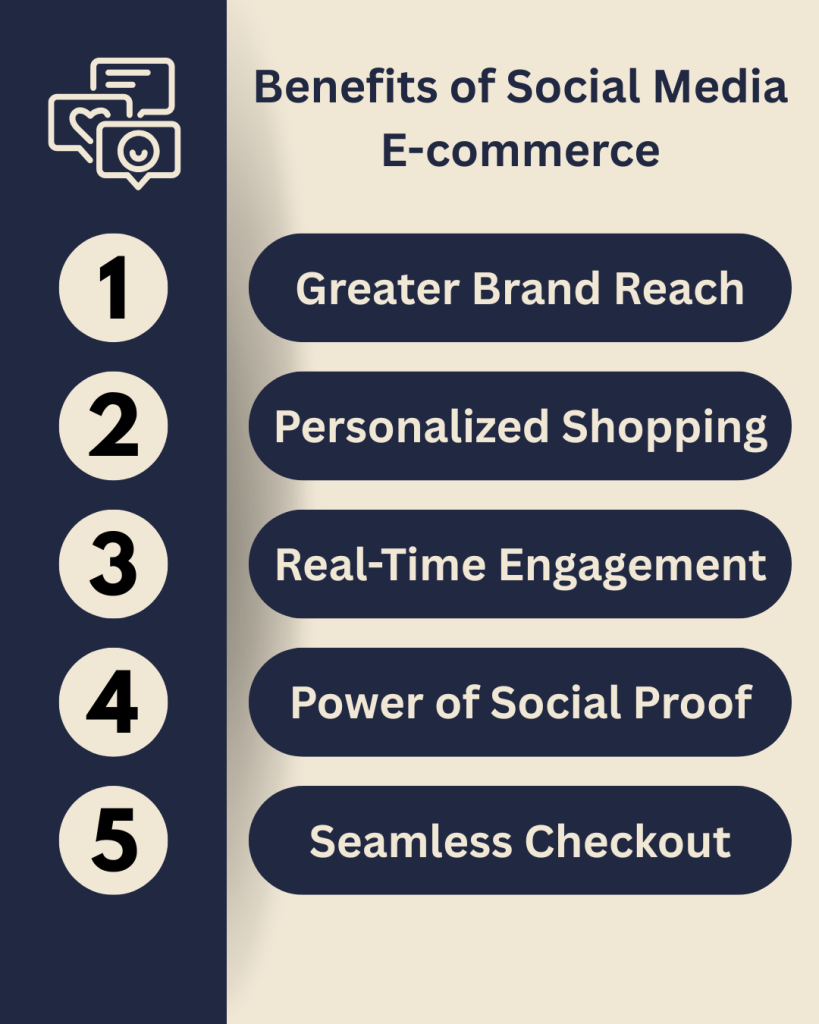
Social media has evolved from a marketing tool into a direct sales channel that empowers both brands and consumers.
- Greater Brand Reach: Social platforms enable businesses to connect with millions across diverse demographics. Through viral posts, influencer campaigns, and active communities, brands boost recognition and attract loyal customers.
- Personalized Shopping: AI-driven recommendations on apps like Instagram and TikTok tailor product suggestions based on user preferences. This boosts conversions and enhances the shopping experience with more relevant offers.
- Real-Time Engagement: Instant communication through comments, DMs, and live sessions creates a sense of trust and authenticity. Quick responses strengthen customer relationships.
- Power of Social Proof: Testimonials, references from influencers, and content created by users enhance the credibility of a brand. Observing others utilizing and appreciating products promotes quicker and more assured buying decisions.
- Seamless Checkout: In-app shopping tools, “Shop Now” buttons, and live purchase links make transactions frictionless. This smooth buying journey reduces cart abandonment and drives higher sales.
Its integration with e-commerce platforms delivers unmatched reach, engagement, and personalization that traditional retail models can’t replicate.
Key Trends
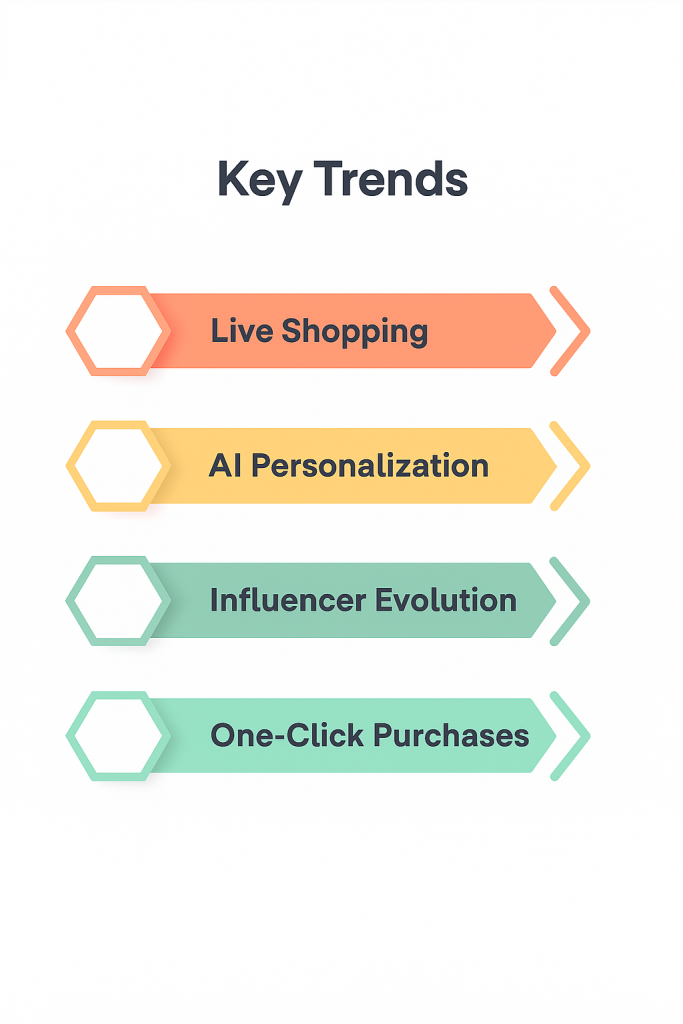
The e-commerce environment in 2025 is transforming due to innovation, automation, and the smooth integration of content with commerce. Social media platforms have evolved beyond mere marketing venues—they are becoming fully-fledged shopping ecosystems.
- Live Shopping: Live streaming has become a core sales strategy, allowing brands to showcase products in real-time and interact with audiences instantly.
- AI Personalization: Artificial Intelligence tailors every stage of the buying process, from product recommendations to ad targeting. Personalized feeds help shoppers discover items that match their style and preferences, improving retention and conversion rates.
- Influencer Evolution: Influencer marketing has matured beyond celebrity endorsements. In 2025, micro and nano influencers dominate, offering genuine connections and niche credibility that drive higher engagement and trust.
- One-Click Purchases: Integrated payment systems and one-click checkout options make buying effortless. Users can complete purchases without leaving the app, reducing friction and making social shopping faster than ever.
Major Social Media Platforms
Instagram & Threads

Instagram has transformed into a comprehensive shopping ecosystem where inspiration seamlessly aligns with immediate purchasing. Shoppable posts, reels, and stories enable consumers to acquire products without exiting the app.
Brands utilize influencer marketing to craft lifestyle-oriented narratives that boost authenticity and engagement. This visual-centric strategy maintains users’ emotional ties to the content they encounter.
TikTok
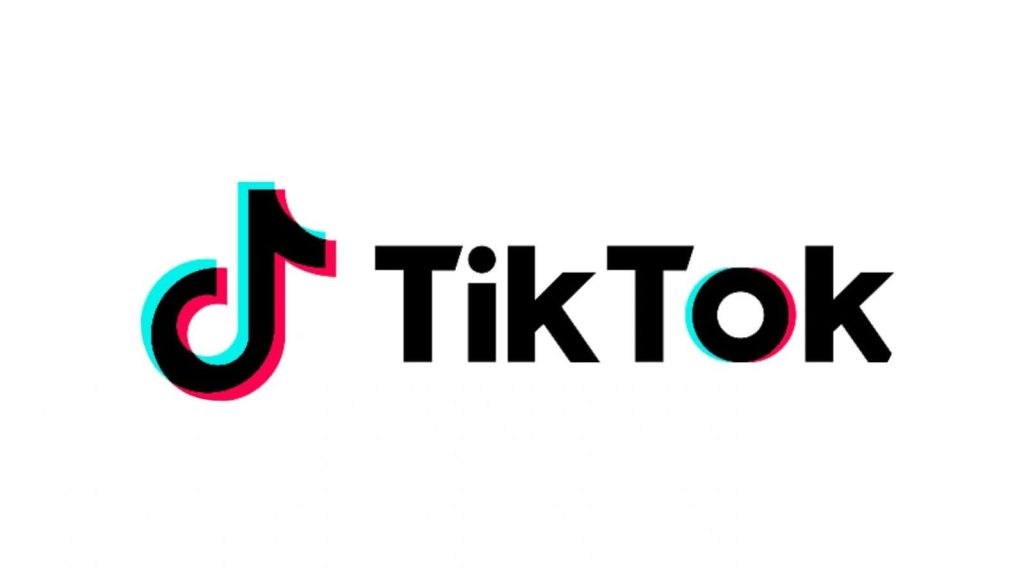
TikTok has transformed the way consumers find and purchase products, merging entertainment with commerce effortlessly. Its algorithm-based feed quickly exposes users to popular products within moments.
The combination of short-form videos and viral challenges boosts impulse buying, converting trends into instant sales chances.
YouTube

YouTube serves as the dominant platform for storytelling in social e-commerce, providing brands with the opportunity to forge deeper connections through extended content. Tutorials, reviews, and vlogs naturally sway purchasing choices.
The addition of YouTube Shopping allows viewers to buy products straight from videos, seamlessly combining content with commerce.
Live shopping events take this a step further by integrating real-time engagement with immediate sales prospects—transforming audience trust into quantifiable conversions.

Facebook remains a cornerstone of e-commerce thanks to its extensive user base and integrated marketplace. It serves as a central point for local sellers and global brands aiming for direct consumer engagement.
The Shops feature allows businesses to display their product catalogs on both Facebook and Instagram, providing a seamless shopping experience across platforms.
Additionally, community groups on Facebook enhance brand-customer connections, fostering authentic conversations and building loyalty.

Pinterest functions as a visual discovery platform where inspiration seamlessly translates into purchase intent. Users are actively on the lookout for ideas, which increases their likelihood of converting when they encounter relevant products.
Shoppable pins and product catalogs streamline this experience by merging creativity with commerce in just one click.
In contrast to other platforms, Pinterest’s timeless content consistently generates traffic and conversions well beyond the initial posting, providing ongoing visibility for brands.
Consumer Behavior in the Social Era
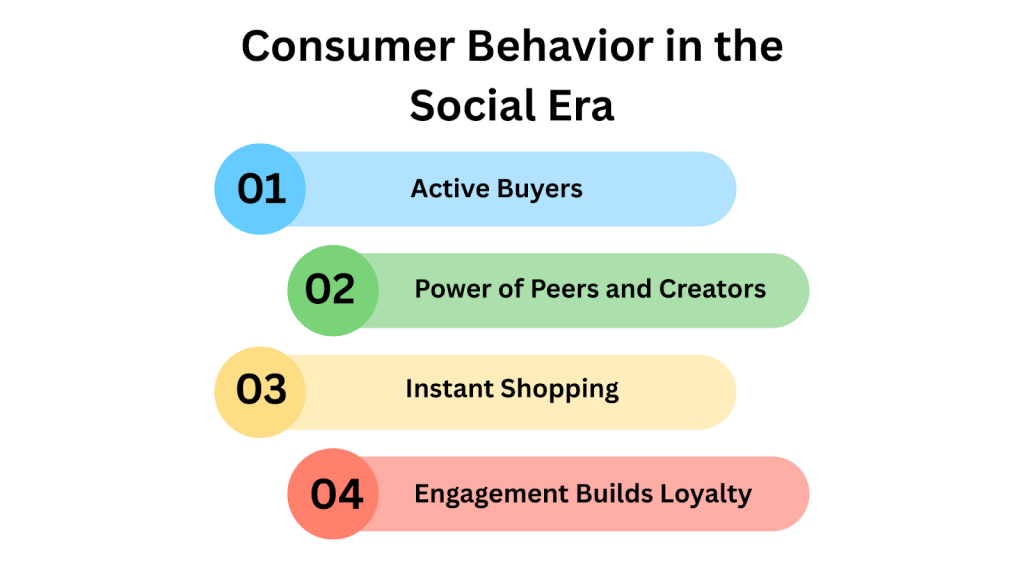
Social media has revolutionized the way people discover, evaluate, and engage with brands.
- Active Buyers: Social media has revolutionized the way people discover, evaluate, and engage with brands. Consumers today are more informed, expressive, and emotionally invested, reshaping e-commerce connectivity.
- Power of Peers and Creators: Modern shoppers no longer just make purchases—they co-create brand stories through reviews, shares, and discussions. Their engagement influences how other consumers perceive a brand’s authenticity and credibility.
- Instant Shopping: Speed and relevance define today’s shopping experience. AI-driven recommendations and in-app purchasing options cater to the modern need for quick satisfaction and tailored discovery.
- Engagement Builds Loyalty: Loyalty now stems from connection, not convenience. When brands foster meaningful interaction and emotional resonance, customers naturally evolve into long-term advocates and repeat buyers.
Consumers today are more informed, expressive, and emotionally invested than ever before, reshaping how e-commerce connects with them.
AI and Personalization
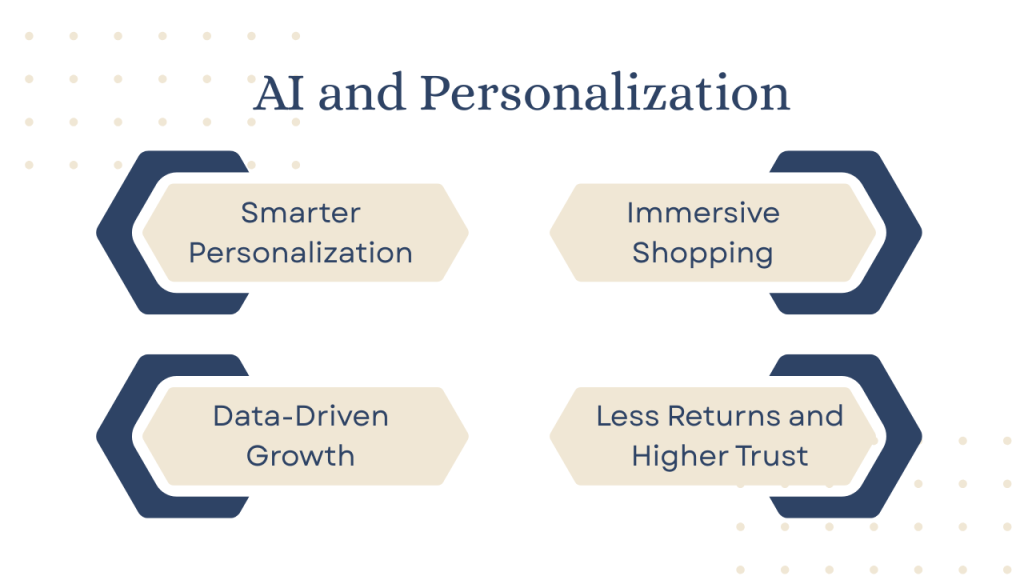
Social media e-commerce thrives on advanced technologies like AI, AR, and data analytics. These innovations aren’t just tools; they’re growth drivers that make shopping smarter, faster, and more human-centered.
- Smarter Personalization: AI turns customer data into personalized experiences, ensuring users see products that match their taste, style, and timing. This precision helps brands connect emotionally and boosts conversion rates.
- Immersive Shopping: Augmented Reality brings products to life before purchase. Shoppers can try on clothes, preview accessories, or visualize furniture in their homes, reducing doubt and making buying decisions more confident and enjoyable.
- Data-Driven Growth: Data analytics gives brands a deeper understanding of audience behavior. With insights into preferences, businesses can refine strategies, predict demand, and create marketing campaigns.
- Less Returns and Higher Trust: By helping customers make more informed choices through AI and AR previews, brands see fewer returns and higher satisfaction rates. This builds long-term trust and repeat purchases.
Opportunities for Brands & Retailers
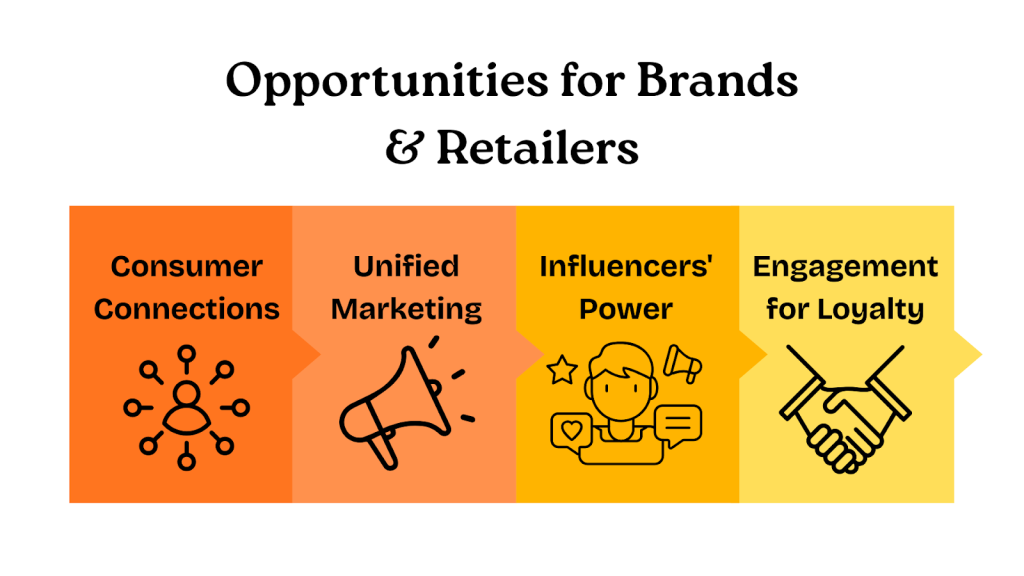
The growth of social commerce has transformed how brands connect, communicate, and convert.
- Consumer Connections: Brands can now interact with shoppers in real time, fostering trust and loyalty through instant responses and engagement.
- Unified Marketing: Social media platforms allow businesses to promote and sell simultaneously—minimizing reliance on traditional e-commerce channels.
- Influencers’ Power: Partnerships with creators and active use of user-generated content help brands humanize their image and strengthen credibility.
- Engagement for Loyalty: Interactive campaigns and two-way communication create emotional bonds, turning casual buyers into long-term advocates.
By merging marketing, sales, and engagement into a single ecosystem, businesses can now build stronger, more direct relationships with their audiences.
Future of Social Media E-commerce
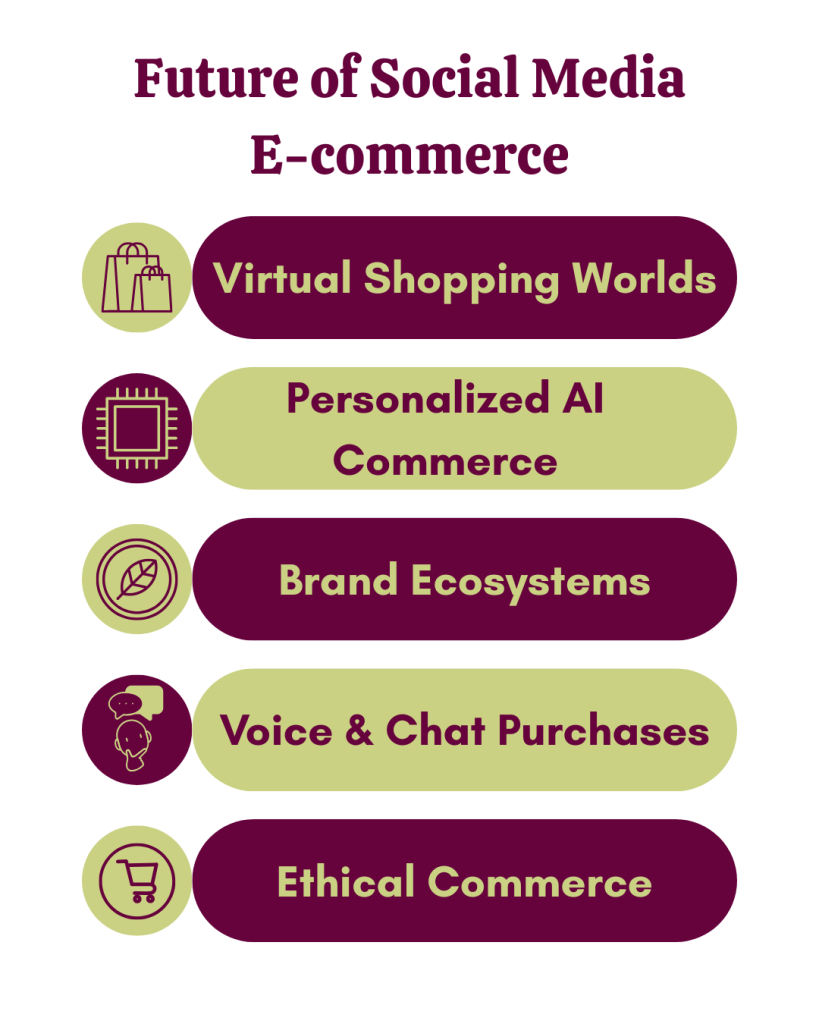
The upcoming stage of social commerce will be propelled by more intelligent technology, enhanced personalization, and an even smoother integration of content with commerce.
- Virtual Shopping Worlds: Metaverse-inspired platforms will enable immersive, 3D shopping experiences. Consumers will explore digital stores and shop collaboratively in real-time environments.
- Personalized AI Commerce: AI will evolve from suggesting products to predicting consumer moods and intent. Shopping feeds will adapt instantly, making every online experience unique and personalized.
- Brand Ecosystems: Influencers won’t just promote products, they’ll build their own branded storefronts. Social platforms will empower creators to become independent retailers.
- Voice & Chat Purchases: Conversational AI and voice assistants will make purchases faster and hands-free. Shoppers will be able to buy directly through voice commands or in-chat recommendations across platforms.
- Ethical Commerce: As awareness grows, consumers will demand transparency and sustainability. Social platforms will highlight eco-friendly brands, influencing the next generation of conscious shoppers.
Conclusion
Social media has transformed from a means of connection into a robust marketplace founded on engagement, trust, and authenticity. It’s not merely about visibility anymore; it’s about fostering meaningful shopping experiences through interaction.
Brands that incorporate social commerce into their fundamental strategy are reshaping how consumers find and purchase products. With AI-driven personalization and creator-led engagement, the line between content and commerce continues to blur.
As technology progresses, the relationship between social connection and shopping will only strengthen. The future of e-commerce isn’t confined to standalone websites—it exists where conversations, trends, and communities flourish.
Deepak Wadhwani has over 20 years experience in software/wireless technologies. He has worked with Fortune 500 companies including Intuit, ESRI, Qualcomm, Sprint, Verizon, Vodafone, Nortel, Microsoft and Oracle in over 60 countries. Deepak has worked on Internet marketing projects in San Diego, Los Angeles, Orange Country, Denver, Nashville, Kansas City, New York, San Francisco and Huntsville. Deepak has been a founder of technology Startups for one of the first Cityguides, yellow pages online and web based enterprise solutions. He is an internet marketing and technology expert & co-founder for a San Diego Internet marketing company.

